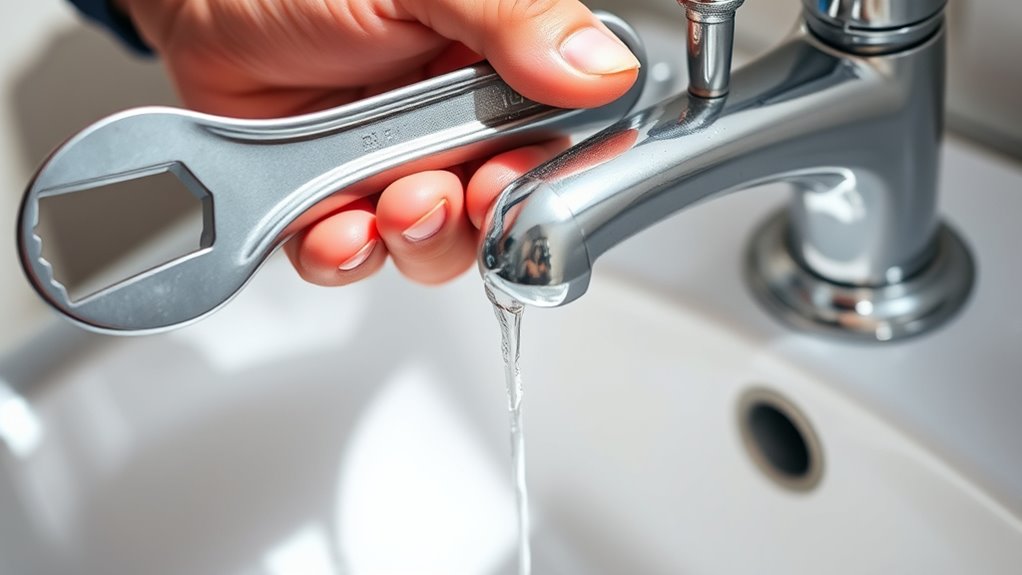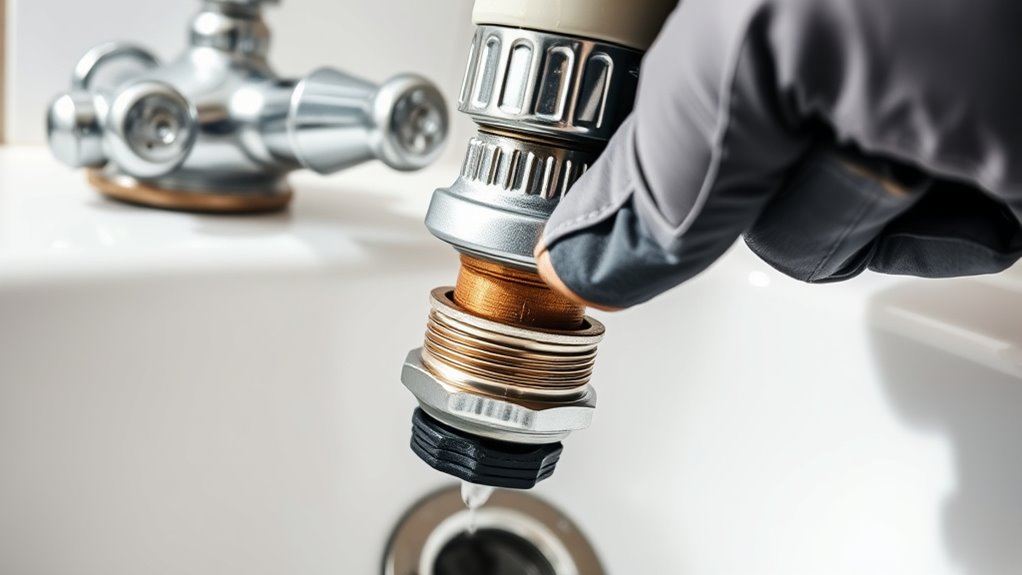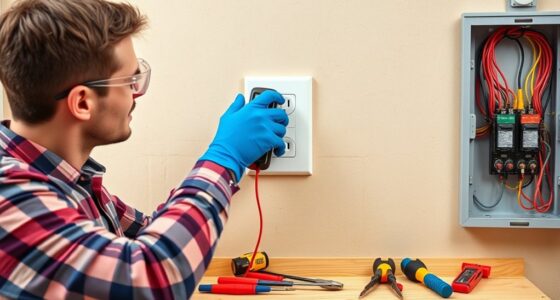To fix a leaky faucet, first turn off the water supply under the sink. Remove the handle using appropriate tools like a wrench or pliers. Check the washers, O-rings, or the cartridge for signs of damage or wear. Replace any worn parts with new ones, then reassemble the faucet tightly. If the leak persists, consider replacing the entire cartridge or seek further tips to prevent future issues. Keep learning to confidently handle similar plumbing problems.
Key Takeaways
- Turn off the water supply under the sink before starting repairs.
- Remove the faucet handle using appropriate tools like a screwdriver or wrench.
- Inspect and replace worn washers, O-rings, or the cartridge if necessary.
- Tighten loose fittings and ensure all components are properly seated.
- Test the faucet for leaks and restore water supply after repairs.

Ever wondered how your home stays supplied with clean water and stays free of waste? It all comes down to a well-designed plumbing system that handles water delivery and waste removal efficiently. Your home plumbing splits into three main parts: water supply, water heating, and drainage. Water supply typically comes from city mains or private wells, depending on where you live. City water is delivered through underground mains with branch lines leading to your home, and it’s usually regulated for quality and pressure. If you’re off-grid, your well supplies water, but its quality and quantity can vary. Either way, proper connection and maintenance are key to ensuring safe, clean water reaches your faucets.
Understanding these basics helps you identify and fix common plumbing issues. When it comes to fixing a leaky faucet, knowing how your plumbing works makes the task easier. Start by turning off the water supply under the sink—this prevents flooding and water waste. Next, remove the faucet handle using a screwdriver or appropriate tool. Once the handle is off, you’ll see parts like the cartridge, O-rings, or washers, which are often the culprits behind drips. Worn or damaged washers or O-rings are the usual suspects. Replacing them is straightforward if you have the right tools, like a pipe wrench, adjustable wrench, and pliers, which are essential in your plumbing toolkit. Remember to keep a towel handy to catch any residual water.
Turning off the water, removing the handle, and replacing worn washers can quickly fix a leaky faucet.
Inspect the components carefully—if they’re cracked or worn, swap them out with new parts. Tightening loose fittings or replacing old washers often stops leaks immediately. If the leak persists, the faucet cartridge might need replacing, which sometimes requires removing the entire fixture. Always shut off the water before working on the fixture to prevent accidents. Properly tightened and replaced parts should do the trick, but if leaks continue, it may be time to consult a professional. Additionally, understanding the importance of contrast ratio can help you choose fixtures that ensure clear, sharp water flow visuals during your home renovations.
Regular maintenance helps prevent leaks and other plumbing problems. Check your visible pipes and fixtures for corrosion or damage, and ensure fixtures are securely mounted to avoid undue stress on pipes. Remember, keeping water pressure within normal limits and inspecting shut-off valves ensures you can handle emergencies quickly. With a basic understanding of how your plumbing system works, fixing a leaky faucet becomes a manageable task, saving you water and money. Taking care of minor repairs promptly also prevents bigger issues down the line, ensuring your home stays comfortable, safe, and efficient.
Frequently Asked Questions
How Do I Identify the Type of Faucet I Have?
To identify your faucet type, start by examining its design and controls. Look at the number of handles—single or double—and note if it’s mounted on the wall or sink. Next, check the internal mechanism by turning it on and off; listen for a smooth or rough operation. Visual cues like height and shape also help. Knowing these details helps determine if you have a ball, cartridge, or compression faucet.
What Tools Are Necessary for Fixing a Leaky Faucet?
To fix a leaky faucet, you’ll need essential hand tools like screwdrivers, an adjustable wrench, needle-nose pliers, slip-joint pliers, a utility knife, and safety gear like gloves and glasses. Specialized tools such as penetrating oil, Teflon tape, a basin wrench, channel-type pliers, and faucet repair kits are also helpful. These tools help you remove, replace, and seal parts effectively, ensuring a proper, leak-free repair.
When Should I Call a Professional Plumber Instead?
When should you call a professional plumber? If DIY fixes don’t stop leaks, water pressure remains low, or drains stay slow, it’s time to get help. Also, if you notice odd noises, water not coming through, or access is difficult, don’t risk further damage. For emergencies, safety concerns, or complex problems involving gas or electrical issues, calling a pro guarantees the job gets done safely and correctly.
How Can I Prevent Future Leaks in My Faucet?
To prevent future leaks, you should regularly inspect your faucet for signs of wear or damage. Keep all parts tight and clean to avoid corrosion and mineral buildup. Replace worn-out washers and O-rings promptly, and guarantee proper installation of all components. Maintaining consistent water pressure and following a scheduled maintenance routine can also help prevent leaks, saving you time and money on repairs down the line.
Are There Eco-Friendly Options for Fixing Leaks?
Did you know that a dripping faucet can waste up to 3,000 gallons of water annually? When fixing leaks, opt for eco-friendly options like natural lubricants and recycled materials. Use green cleaning solutions to maintain your faucet, and choose energy-efficient models whenever possible. Employ tools like pipe repair clamps for quick fixes, and always prioritize sustainable practices to reduce environmental impact and conserve water.
Conclusion
So, now you’re basically a faucet whisperer—ready to fix leaks and save water (and maybe impress your neighbors). Who knew that a little wrench and some patience could turn you into the household hero? Remember, next time a drip dares to ruin your day, you’ve got the skills to silence it—without calling a plumber. Now go forth and conquer those leaks, because a little know-how can turn you into the ultimate DIY legend.










